There’s a lot of discussion in the fitness industry about whether crash dieting can cause metabolic damage. In this article, we’ll take on this interesting topic and separate fact from fiction. We’ll also teach you exactly why crash diets might be linked to struggling to maintain your weight in the future.
- Want to listen instead of read? Download the audio recording here…
++++
Despite working out consistently and intensely, plus eating carefully, you’re not losing weight (or not losing it as fast as you’d like or expect).
Or you were losing weight consistently… until recently. Now you’re stuck—even though you’re working as hard as ever.
Or when you were younger, you were super fit. Maybe you did fitness competitions. Maybe you did some crash diets. But now, even when you put in the same effort, you just can’t seem to get as lean.
“Is my metabolism damaged?”
Precision Nutrition Coaching clients ask us this question all the time.
(If you’re a health, fitness or wellness professional, you’ve probably heard it from your clients or patients too.)
Can months or years of dieting do some kind of long-term harm to the way the human body processes food?
Not exactly.
But gaining and losing fat can change the way your brain regulates your body weight.
To understand this answer let’s explore how human metabolism actually works. Then we’ll talk about whether the metabolism can actually be damaged.
Note: This post delves into the science of energy balance, thermodynamics, and metabolic regulation. If you love learning this stuff, feel free to dig in.
If, on the other hand, you’re simply looking for solid, research-backed advice on how to lose fat and break weight-loss plateaus, feel free to skip to the summary at the end.
Energy balance: The laws of physics still apply.
You need a certain amount of energy (in the form of calories) to stay alive, as well as to move around. You can get this energy from food, or you can retrieve it from stored energy (e.g. your fat tissue).
In theory:
- If you eat less energy than you expend, you should lose weight.
- If you do the opposite (i.e. eat more energy than you expend), you should gain weight.
In other words:

*We use the term “body stores” deliberately as it represents the tissues available for breakdown (fat, muscle, organ, bone, etc) and excludes water (which can change body weight independently of energy balance).
This relationship between ‘energy in’ and ‘energy out’ is called the Energy Balance Equation, and it’s the most commonly accepted model for calculating a person’s energy balance and how much weight they’ll lose or gain over time.
While the Energy Balance Equation determines body weight, it doesn’t tell us much about body composition, which is influenced by things like sex hormone levels, macronutrient intake (especially protein), exercise style / frequency / intensity, age, medication use, genetic predisposition, and more.
Understandably, people get really frustrated and confused with the Energy Balance Equation when the numbers don’t seem to add up, or their results don’t match their expectations. (This is a good lesson, by the way, about the importance of adjusting your expectations to match observable reality.)
And it’s a fair frustration. Most of the time, the numbers don’t add up.
Importantly:
This mismatch between expectations versus reality is not because the Energy Balance Equation is wrong, or a myth. Nobody’s body defies the laws of physics, even though it seems like that sometimes.
It’s because the equation is more complicated than it sounds.
Many factors affect the Energy Balance Equation; they aren’t mutually exclusive. What you do to ‘energy in’ affects what happens to ‘energy out’. And vice versa.
“Eat less, move more” is a good start. (Most of us could probably benefit from eating a little less and getting a little more daily activity.)
But that advice alone isn’t enough. It doesn’t take all of the complex, intersecting factors into account.
Let’s take a look at some of these factors, starting with the ‘energy in’ part of the equation.
‘Energy in’ is trickier than you think.
Reason 1: The number of calories in a meal likely doesn’t match the number of calories on the labels or menu.
This might sound hard to believe, but it’s true… the way companies (and even the government) come up with calorie and nutrient estimates is incredibly complex, rather imprecise, and centuries-old. As a result, food labels can be off by as much as 20-25 percent.
And even if those food labels were correct:
Reason 2: The amount of energy a food contains in the form of calories is not necessarily the amount of energy we absorb, store, and/or use.
Remember that the food we eat has to be digested and processed by our unique bodies. The innumerable steps involved in digestion, processing, absorption, storage, and use—as well as our own individual physiological makeup—can all change the energy balance game.
So, for instance:
- We absorb less energy from minimally processed carbohydrates, and fats, because they’re harder to digest.
- We absorb more energy from highly processed carbohydrates and fats, because they’re easier to digest. (Think of it this way: The more “processed” a food is, the more digestion work is already done for you.)
For example, research has shown that we absorb more fat from peanut butter than from whole peanuts. The researchers found that almost 38 percent of the fat in peanuts was excreted in the stool, rather than absorbed by the body. Whereas seemingly all of the fat in the peanut butter was absorbed.
In addition:
- We often absorb more energy from foods that are cooked (and/or chopped, soaked, blended) because those processes break down plant and animal cells, increasing their bioavailability.
When eating raw starchy foods (like sweet potatoes), we absorb very few of the calories. After cooking, however, the starches are much more available to us, tripling the number of calories absorbed.
Interestingly, allowing starchy foods to then cool before eating them decreases the amount of calories we can extract from them again. (This is mostly due to the formation of resistant starches).
Finally:
- We may absorb more or less energy depending on the types of bacteria in our gut.
Some people have larger populations of a Bacteroidetes (a species of bacteria), which are better at extracting calories from tough plant cell walls than other bacteria species.
Here’s an interesting example of this whole process at work. Recently, USDA researchers asked test subjects to consume 45 grams (about 1 ½ servings) of walnuts daily for three weeks.
What they found was that, on average, people only absorbed 146 of the 185 calories in the nuts. That’s 79 percent of the calorie content on the label.
In similar research, people also absorbed only 80 percent of the calories in almonds, and 95 percent of the calories in pistachios.
Beyond the average, there were individual differences: Some people absorbed more of the energy in the nuts, while some absorbed less (likely due to the differing populations of bacteria in their large intestines).
In the end, by eating a diet rich in whole, minimally processed foods, the number of calories you absorb can be significantly less than what you expect. Plus they require more calories to digest.
Conversely, you will absorb more calories by eating lots of highly processed foods, plus burn fewer calories in the digestive process. (In addition, highly processed foods are less filling, more energy dense, and more likely to cause overeating.)
Since the number of calories someone thinks they’re consuming could be off by 25 percent (or more), their carefully curated daily intake of 1,600 calories could really be 1,200… or 2,000.
This means:

As you can see, there’s a big margin of error for energy input, even if you’re a conscientious calorie counter. This doesn’t invalidate the Energy Balance Equation. It just means that if you want an accurate calculation, you probably have to live in a fancy metabolic lab.
For most people, it’s not worth the effort (that’s one reason why Precision Nutrition moved to a hand-based measuring model for portions).
‘Energy out’ varies a lot from person to person.
‘Energy out’—again, energy burned through daily metabolism and moving you around—is a dynamic, always-changing variable.
There are four key parts to this complex system:
1. Resting metabolic rate (RMR)
RMR is the number of calories you burn each day at rest, just to breathe, think, and live. This represents roughly 60 percent of your ‘energy out’ and depends on weight, body composition, sex, age, genetic predisposition, and possibly (again) the bacterial population of your gut.
A bigger body, in general, has a higher RMR.
For instance:
- A 150-pound man might have an RMR of 1583 calories a day.
- A 200-pound man might have an RMR of 1905 calories.
- A 250-pound man might have an RMR of 2164 calories.
Crucially, RMR varies up to 15 percent from person to person. If you’re that 200-pound guy with an RMR of 1905 calories, another guy just like you on the next treadmill might burn 286 more (or fewer) calories each day with no more (or less) effort.
2. Thermic effect of food (TEF)
This may surprise you, but it takes energy to digest food. Digestion is an active metabolic process. (Ever had the “meat sweats” or felt hot after a big meal, especially one with lots of protein? That’s TEF.)
TEF is the number of calories you burn by eating, digesting, and processing your food. This represents roughly 5-10 percent of your ‘energy out’.
In general, you’ll burn more calories in your effort to digest and absorb protein (20-30 percent of its calories) and carbs (5-6 percent) than you do fats (3 percent).
And as noted before, you’ll burn more calories digesting minimally processed whole foods compared to highly processed foods.
3. Physical activity (PA)
PA is the calories you burn from purposeful exercise, such as walking, running, going to the gym, gardening, riding a bike, etc.
Obviously, how much energy you expend through PA will change depending on how much you intentionally move around.
4. Non-exercise activity thermogenesis (NEAT)
NEAT is the calories you burn through fidgeting, staying upright, and all other physical activities except purposeful exercise. This, too, varies from person to person and day to day.
This means:

Each of these is highly variable. Which means the ‘energy out’ side of the equation may be just as hard to pin down as the “energy in” side.
So, while the Energy Balance Equation sounds simple in principle, all these variables make it hard to know or control exactly how much energy you’re taking in, absorbing, burning, and storing.
Here’s the entire equation:

When you try to outsmart your body and it outsmarts you back.
Even if all the variables in the final equation above were static, the Energy Balance Equation would be complicated enough. But things get crazy when you consider that altering any one of the variables causes adjustments in other, seemingly unrelated variables.
This is a good thing, of course. Our human metabolisms evolved to keep us alive and functioning when food was scarce. One consequence:
When ‘energy in’ goes down, ‘energy out’ goes down to match it. (You burn fewer calories in response to eating less).
Not in everybody. And not perfectly. But that’s how the system is supposed to work. That’s how our bodies avoid unwanted weight loss and starvation. It’s how humans have survived for 2 million years. The body fights to maintain homeostasis.
Likewise, when ‘energy in’ goes up, ‘energy out’ tends to go up too. (You burn more calories in response to eating more).
To illustrate this point, here’s how your body tries to keep your weight steady when you take in less energy and start to lose weight*.
- Thermic effect of food goes down because you’re eating less.
- Resting metabolic rate goes down because you weigh less.
- Calories burned through Physical activity go down since you weigh less.
- Non-exercise activity thermogenesis goes down as you eat less.
- Calories not absorbed goes down and you absorb more of what you eat.
*This response is particularly modest at first. But the adaptation really ramps up as you lose more weight. (Or if you’re starting out lean and trying to get super-lean).
Check out what this looks like:
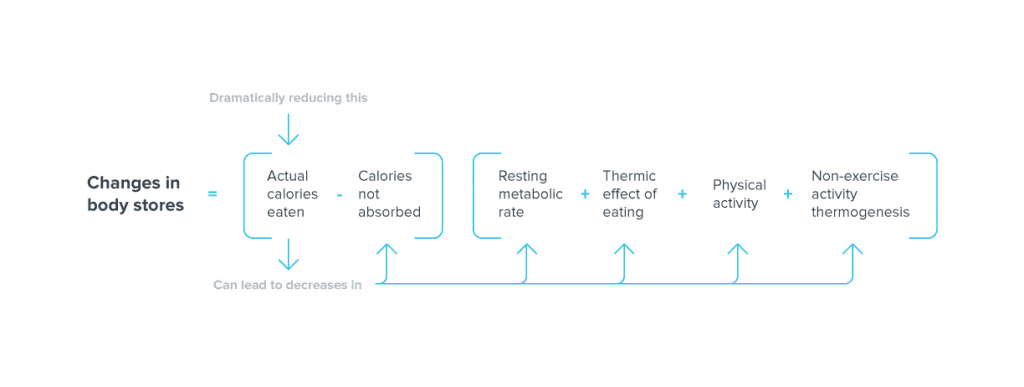 In addition to these tangible effects on the equation, reducing actual calories eaten also causes hunger signals to increase, causing us to crave (and maybe eat) more.
In addition to these tangible effects on the equation, reducing actual calories eaten also causes hunger signals to increase, causing us to crave (and maybe eat) more.
The net effect leads to a much lower rate of weight loss than you might expect. In some cases, it could even lead to weight re-gain.
To add insult to injury, a rise in cortisol from the stress of dieting can cause our bodies to hold onto more water, making us feel “softer” and “less lean” than we actually are.
Interestingly, this is just one example of the amazing and robust response to trying to manipulate one variable (in this case, actual calories eaten). There are similar responses when trying to manipulate each of the other variables in the equation.
For example, research suggests that increasing physical activity above a certain threshold (by exercising more) can trigger:
- Increased appetite and more actual calories eaten
- Decreased calories not absorbed as we absorb more of what we eat
- Decreased RMR
- Decreased NEAT
In this case, here’s what the equation would look like:
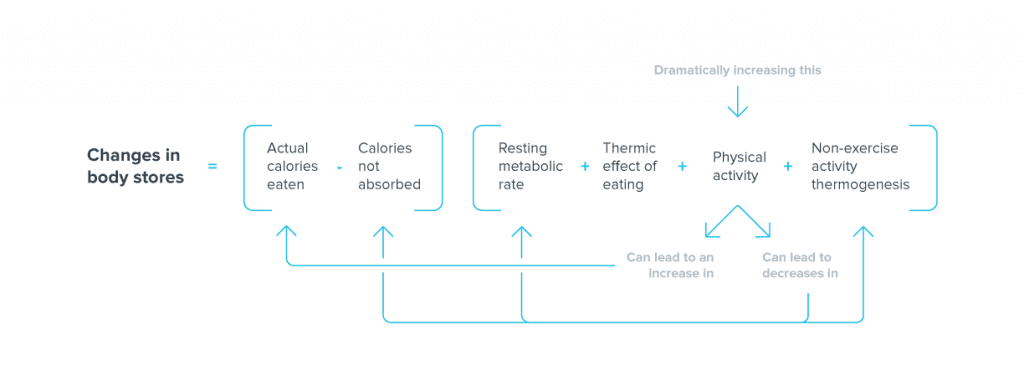 In the end, these are just two of the many examples we could share. The point is that metabolism is much more complicated (and interdependent) than most people realize.
In the end, these are just two of the many examples we could share. The point is that metabolism is much more complicated (and interdependent) than most people realize.
Therefore, trying “what used to work” for you, or relying on calorie counting, often won’t get you the results you want. As your energy balance evolves, so must your strategies for losing fat or maintaining your weight.
Understanding energy balance means setting better expectations about body change.
It’s important to note that if you have lots of body fat to lose, many of these adaptations (i.e. lowered RMR, PA, NEAT, etc) don’t happen right away. But, as you become leaner, this “adaptive thermogenesis” kicks in.
It’s also important to know that how your metabolism reacts to changes in energy balance will be unique to you.
How much you can lose or gain will depend on your age, your genetic makeup, your biological sex, if you’ve had relatively more or less body fat and for how long, what medications you’re taking, the makeup of your microbiome… and probably a whole lot of factors we don’t even know about yet.
But let’s try to simulate how this could work.
Scientists at the National Institutes of Health have studied the data from people who have lost weight, and created a mathematical model that represents how weight and fat loss actually happens in the real world.
We can play with it, using the Precision Nutrition Weight Loss Calculator.
Let’s start with a 40-year-old male, with a starting weight of 235 lb and a height of 5’10”. We’ll call him Frank.
Frank works a desk job, and is only lightly active outside of work. This calculates that he needs 2,976 calories of energy per day to maintain his current weight.
By knocking off 500 calories per day, his intake drops to 2,476 calories daily. And he doesn’t plan on changing his physical activity.
Now, you’ve probably heard somewhere that a pound is equivalent to 3,500 calories, which means that if we take away those 500 calories from Frank every day, he should lose 1 pound per week (500 x 7 days = 3500 calories).
He should end up at 183 lb after one year of consistently eating 500 fewer calories every day. (According to this math, then, he would weigh 0 lb within 5 years, which should raise some red flags.)
But we know it doesn’t exactly work this way in real life.
At the end of a year, Frank gets on the scale. He’s 205 lb.
What the hell?
That’s 22 pounds more than I should be!
Frank rages to his wife Maria, who smiles knowingly. She’s 40 too, and has been trying to lose weight since having two kids in her mid-30s.
Tell me about it, she says. I’ve lost and gained the same 10 pounds over and over, even though I’ve been exercising and eating pretty healthy.
Then they both think:
Maybe I should try that juice cleanse after all. My body is obviously broken.
Nope, nobody is broken. Don’t hit that juice cleanse just yet.
Instead, Frank and Maria could both benefit from a clear understanding of how weight loss actually works. Then they can set appropriate behavior goals, and have realistic expectations for their progress.
(Postscript: Frank and Maria decide against the juice fast and enroll in Precision Nutrition Coaching. At the end of a year, Maria “only” lost a total of 7 lb, but has gained 5 lb of muscle [which means she’s lost 12 lb of fat]. Her firm arms and glowing skin are the envy of the other moms. Frank is down to a fit 185 lb and trying to figure out how to convince Maria that he should buy a mountain bike.)
So, does dieting damage the metabolism?
Despite what you may have heard:
No, losing weight doesn’t “damage” your metabolism.
But because of the adaptations your body undergoes in response to fat loss (to prevent that fat loss, in fact), ‘energy out’ for those who have lost significant weight will always be lower than for people who were always lean.
Rather:
Losing weight, and keeping it off, is accompanied by adaptive metabolic, neuroendocrine, autonomic, and other changes.
These changes mean that we expend less energy—around 5-10 percent less (or up to 15 percent less at extreme levels) than what would be predicted based on just weighing less.
Unfortunately, because of this adaptive response, someone who has dieted down will often require 5-15 percent fewer calories per day to maintain the weight and physical activity level than someone who has always been that weight.
(Or even less, potentially, because as we learned in the very beginning, the RMR of people of the exact same age/weight/etc. can still vary by up to another 15 percent.)
This means someone who was never overweight might need 2,500 calories to maintain their weight, while someone who had to diet down to that weight may need only 2,125-2,375 calories to hold steady.
We don’t know how long this lowered energy expenditure lasts. Studies have shown that it can hang around for up to 7 years after weight loss (or more; 7 years is as far as it’s been studied). This likely means it’s permanent, or at least persistent.
This is extra relevant for people who have repeatedly dieted, or for fitness competitors who may repeatedly fluctuate between being extremely lean and being overweight in the off-season.
I don’t have data to back this up (to my knowledge no one has studied it), but adaptive thermogenesis seems to react more strongly or more rapidly with each successive yo-yo of extreme body fat fluctuations.
All of this explains why some people can feel like they’ve “damaged” their metabolism through repeated dieting. (And why some experts suggest “metabolic damage” is a real thing.)
But nothing really has been “damaged”.
Instead, their bodies have just become predictably more sensitive to various hormones and neurotransmitters. Their metabolic rates are understandably lower than predicted by various laboratory equations.
So, where does this leave us?
Even folks whose bodies resist fat loss or muscle gain can accomplish these goals.
All physiological changes—including weight loss or gain, fat loss or gain, and muscle loss or gain—require different efforts and amounts of time for different people.
But even if your body does resist weight loss, you can still lose fat, gain muscle, and dramatically change your body.
Our Precision Nutrition Coaching men’s and women’s Finalist Halls of Fame are clear evidence of that.
What to do next:
Some tips from Precision Nutrition.
The physiology of weight loss is complicated, but the best strategies for losing fat and keeping it off don’t have to be.
1. Eat plenty of protein.
Protein is essential when trying to losing weight / fat for a few reasons.
- Protein helps you keep that all-important lean body mass (which includes connective tissues, organs, and bone as well as muscle).
- Protein significantly increases satiety, which means you feel fuller despite eating less. (And eating more protein often causes people to eat less overall.)
- Just by eating more protein you burn more calories, because of the increased thermic effect of food.
For example, if you’re eating 2,500 calories daily, 15 percent from protein, 50 percent from carbs, and 35 percent from fats (roughly average for US adults), you’re burning approximately 185 calories per day through digestion.
Maintain your total calorie intake but increase protein to 30 percent, drop carbs to 40 percent, and whittle fat to 30 percent, and your TEF goes up to roughly 265 calories per day.
- For most active men: 6-8 palm-sized servings of protein per day.
- For most active women: 4-6 palm-sized servings per day.
For a complete guide to using your hand to measure portions, check out our Calorie Control Guide infographic.
2. Eat a wide variety of fruits, vegetables, quality carbs, and healthy fats.
Vegetables are loaded with vitamins, minerals, phytonutrients, water, and fiber to help you fill up during meals, stay full between meals, keep you healthy, and recover from your workouts.
- We recommend 6-8 fist-sized servings per day for most active men.
- And 4-6 fist-sized servings per day for most active women.
The carbs will fuel training, boost leptin (a super important hormone), keep up sex hormones, and prevent feelings of deprivation.
And the fats also keep up sex hormones, boost the immune system, suppress excess inflammation, and make food taste really good.
- For most active men, this would be 6-8 handfuls of quality carbs, and 6-8 thumbs of healthy fats per day.
- For most active women, 4-6 handfuls of quality carbs and 4-6 thumbs of healthy fats per day.
For a complete guide to using your hand to measure portions, check out our Calorie Control Guide infographic.
3. Adjust your intake as you plateau, or to prevent plateaus.
As your weight loss progresses, you will need to lower your calorie intake further to continue to progress, as your smaller body will burn fewer calories, and your body is adapting to your diet.
Be ready, willing, and able to adjust portion amounts by removing 1-2 handfuls of carbs and/or 1-2 thumbs of fats from your daily intake. Then reassess and continue to adjust as needed.
However, one study found that weight loss plateaus have less to do with metabolic adaptations and more to do with “an intermittent lack of diet adherence”. In other words, not actually sticking to a nutrition plan consistently.
Research shows that we usually think we’re eating less and exercising more than we truly are. So do an objective review of your actual energy in and out before assuming your body is blocking your efforts.
4. Understand that this is complex.
So many things influence what, why, and when we choose to eat.
Too often, eating and body size / fatness are blamed on lack of knowledge, lack of willpower/discipline, or laziness. In reality, food intake and body composition are governed by a mix of physiological, biological, psychological, social, economical, and lifestyle influences, along with individual knowledge or beliefs.
One of the simplest ways to make your decision processes easier is to create an environment that encourages good food choices and discourages poor ones. This can mean making changes to your daily routine, who you spend time with, where you spend time, and what food is readily available to you.
But remember that weight loss can and should be relatively slow, so aim to lose about 0.5-1 percent of your body weight per week.
This helps to maintain muscle mass and minimize the adaptive metabolic responses to a lower calorie intake and resulting weight loss. Faster weight loss tends to result in more muscle loss without extra fat loss, as well as a larger adaptive response.
5. Cycle calories and carbs.*
For folks who are trying to get quite lean, at some point you can’t just rely on linear dieting to get you there. By strategically cycling calories and carbs, you can help to limit how much the metabolism-regulating hormone leptin drops (or temporarily boost it back up) – attenuating the adaptive and hunger response.
*Note: This is a higher-level strategy for fitness competitors and elite athletes who need to get very lean (i.e. ~6-9 percent body fat for men, and ~16-19 percent for women). It’s not something for the average person.
6. Refeed periodically.**
When getting to extreme levels of leanness, even strategic calorie and carb cycling might not be enough. So take out the big guns, and employ some periodic re-feeds to temporarily boost leptin and insulin and keep fat loss going.
**Note: This is a higher-level strategy for fitness competitors and elite athletes who need to get very lean (i.e. <6 percent body fat for men, and <16 percent for women).
7. Do a mixture of resistance, cardiovascular, and recovery activity.
Resistance training helps you maintain vital muscle mass, burn calories, and improve glucose tolerance. Cardiovascular exercise improves the health of your cardiovascular system, helps you expend energy, and can improve recovery.
Recovery work (e.g. foam rolling, walking, yoga) helps you maintain consistency and intensity with resistance and cardio training, making them more effective. And it helps to decrease stress (lowering cortisol), which also helps you lose body fat and keep it off.
Aim for 3-5 hours per week of purposeful activity.
8. Find ways to increase NEAT.
Even small increases in activity can account for hundreds of daily calories, and therefore make a big difference in fat loss efforts.
Some ideas: Get a stand-up desk or a treadmill desk; fidget; pace while on the phone; take the stairs; park your car farther away from where you’re going.
9. Develop a solid nightly sleep routine and manage your stress.
Sleep is just as important to your success as nutrition and activity levels. Don’t pretend that you can get by with less. It simply isn’t true.
Often, when people lower their stress, they lose a lot of body water. Then they also notice that they may have lost fat too. (Plus, they may discover that chronic inflammation goes down—another win.)
This includes mental and emotional stress. Research on cognitive dietary restraint (i.e. worrying and stressing out about food) shows that constantly and negatively fixating on what you eat (or don’t) can have the same unhealthy effect as actually dieting stringently.
Yet we need some stress to actually help with progress and growth, so find your stress sweet spot.
10. Have some self-compassion.
There are going to be meals or days where you don’t eat as you “should”. It’s OK. It happens to everyone. Recognize it, accept it, forgive yourself, and then get back on track.
Research actually shows that self-compassion and flexible eating is associated with lower BMI and a healthier body weight, lower self-reported calorie intake, less anxiety and stress, and a better relationship with food.
References
Click here to view the information sources referenced in this article.
If you’re a health and fitness pro…
When your clients are stressed and exhausted, everything else becomes a struggle: going to the gym, choosing healthy foods, and managing cravings.
But with the right tools, you can help your clients overcome obstacles like chronic stress and poor sleep—leading them toward the lasting health transformations they’ve always wanted.
PN’s Level 1 Sleep, Stress Management, and Recovery (SSR) Coaching Certification will give you these tools. And it’ll give you confidence and credibility as a specialized coach who can solve the biggest problems blocking any clients’ progress. (You can enroll now in the SSR Certification at a big discount.)

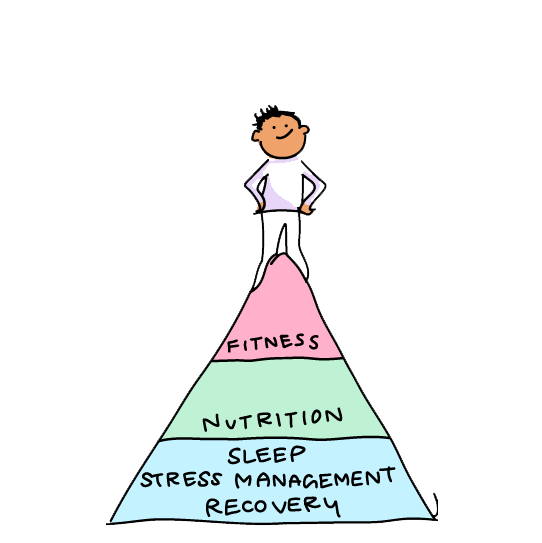
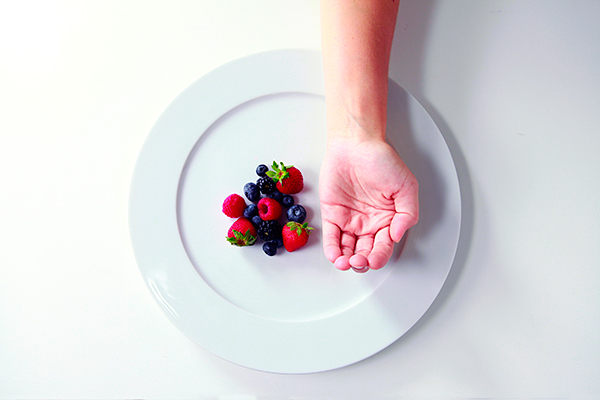
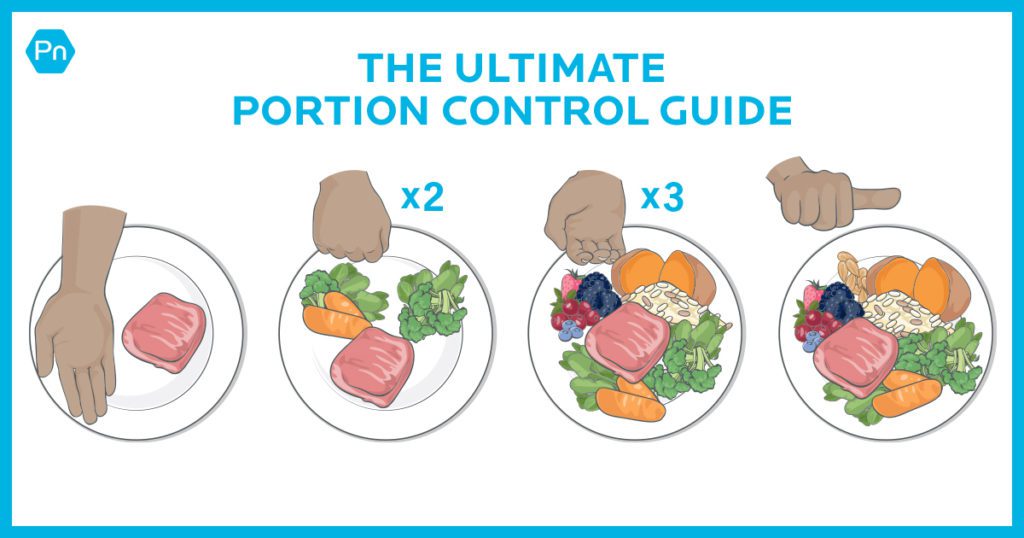

Share